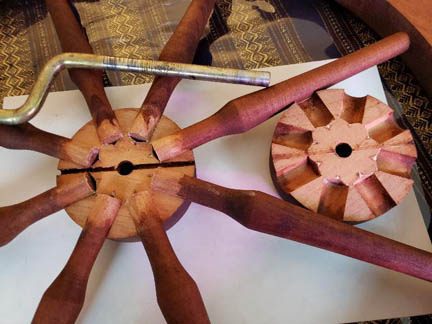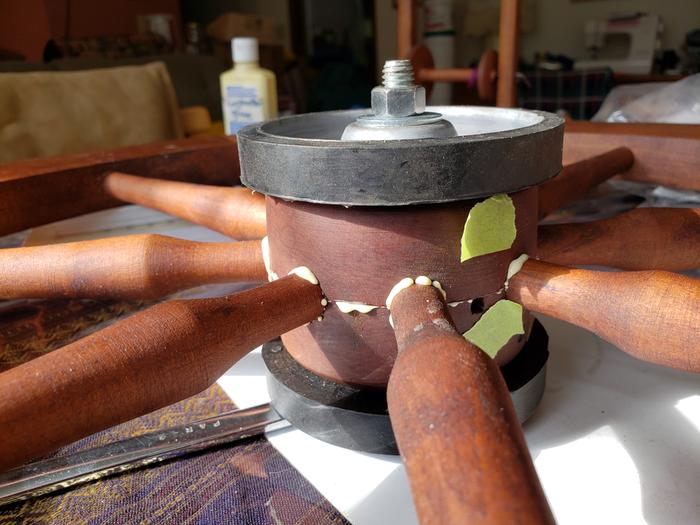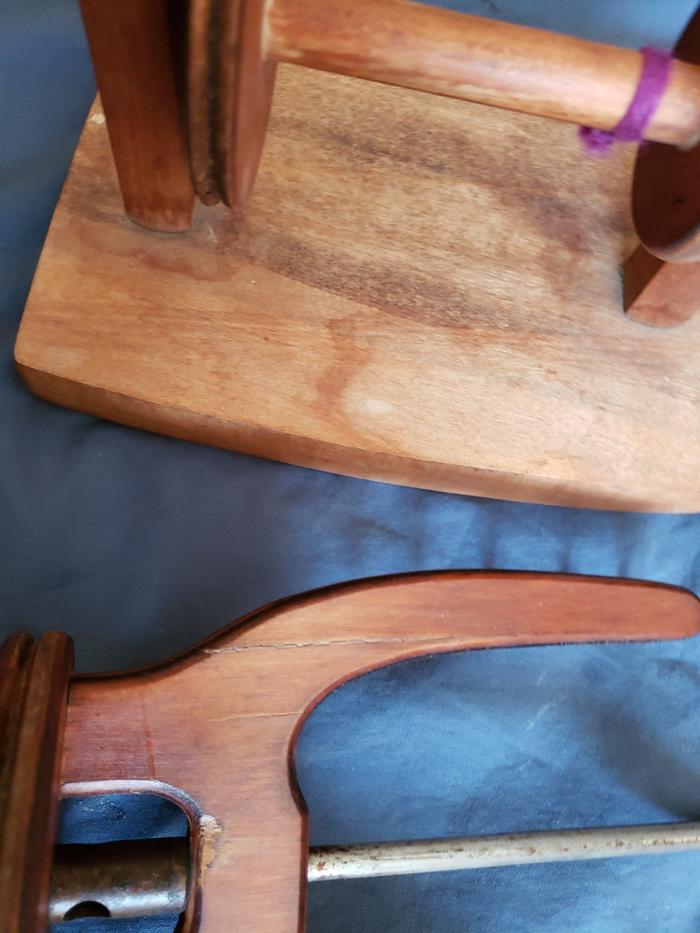
 7
7




Visit Redhawk's soil series: https://permies.com/wiki/redhawk-soil
How permies.com works: https://permies.com/wiki/34193/permies-works-links-threads
 3
3











 1
1















Visit Redhawk's soil series: https://permies.com/wiki/redhawk-soil
How permies.com works: https://permies.com/wiki/34193/permies-works-links-threads











 2
2











 2
2




Visit Redhawk's soil series: https://permies.com/wiki/redhawk-soil
How permies.com works: https://permies.com/wiki/34193/permies-works-links-threads
 2
2




Visit Redhawk's soil series: https://permies.com/wiki/redhawk-soil
How permies.com works: https://permies.com/wiki/34193/permies-works-links-threads























 4
4
















The flyer is made with plywood and the crack is only in a single layer, so I think it's a symptom of the dryness of the wood and unless you feel it will tend to catch the wool, it will be OK in the short term.There is a crack in the flyer
It has all the parts in the picture except that round black thing with the funny hole in it, and, of course the oil is missing!I will look for a source of oil sold separately when we get to that point. If proper oil had come with it, I would have used that. Hubby called (he's in the States for another week) and he suggested WD40, but I suspect you won't approve of that option either, but I also feel that issue isn't critical path. That said, I had to install the flyer myself (it was in a bag with various bits) which I did by following a YouTube video, but the shaft that the bobbin slides on will eventually need some polishing - I recall the video said emery cloth and I'm sure Hubby has some of that, but it will wait until he's back.Is there anything else in the maintenance kit
Absolutely! I'd already figured you'd say that, but I still wanted to give you a heads up as I think the way the hub's broken and the dry wood are related. I read the thread here: https://permies.com/t/54431/permaculture-fiber-arts-tools/fiber-arts/bought-spinning-wheel-photos-questions last night and noted what one member had said about how wood ages. I know this wheel isn't hugely old by some standards, but how wood is cared for makes a big difference. My sister in Ontario refinished a beautiful bedroom set from my grand-parents and she used a lot of linseed oil until, as you say, it stopped soaking it up and it looks gorgeous now. Other fixes first though.Before you start oiling, let's fix that hub. We don't want the oil interacting with the glue.
Visit Redhawk's soil series: https://permies.com/wiki/redhawk-soil
How permies.com works: https://permies.com/wiki/34193/permies-works-links-threads
 1
1











 1
1












 1
1




I agree completely!(I'm going to explain this really simply not because you need it, but for future readers, if they ever have to do this)
Visit Redhawk's soil series: https://permies.com/wiki/redhawk-soil
How permies.com works: https://permies.com/wiki/34193/permies-works-links-threads




Visit Redhawk's soil series: https://permies.com/wiki/redhawk-soil
How permies.com works: https://permies.com/wiki/34193/permies-works-links-threads




Jay Angler wrote:Question: There is "hub pin" showing on both the top and the bottom of the hub, and about the same amount on both. Does this mean that it's one pin going all the way through the hub and axle and out the other side? If so, Hubby has some flat "nail set" type tools that might be the best thing to get the job started. First I will even just try wiggling it.







 4
4






Visit Redhawk's soil series: https://permies.com/wiki/redhawk-soil
How permies.com works: https://permies.com/wiki/34193/permies-works-links-threads
 1
1




I'm thinking I will need some way to support the rim of the wheel in the correct plain, put lots of wood glue around the bases of the spokes and hub parts, assemble the two halves, and then put a lot of weight on it?







 3
3






Visit Redhawk's soil series: https://permies.com/wiki/redhawk-soil
How permies.com works: https://permies.com/wiki/34193/permies-works-links-threads
 2
2




“The most important decision we make is whether we believe we live in a friendly or hostile universe.”― Albert Einstein




Thank you for the compliment. The person who gave it to me wanted to use screws or bolts, but r ranson didn't feel that was her first choice, and I think between B and I we came up with something that will work well. I think the bolt through the center will have kept the alignment in one plain true, but how well I've kept the spokes at right angle to the axle we won't know until the glue sets. Bolts will be the back-up plan!Well, Jay.....I can safely say that my gluing job and overall repair looks a lot uglier and more slap-dash than yours! :-)
Visit Redhawk's soil series: https://permies.com/wiki/redhawk-soil
How permies.com works: https://permies.com/wiki/34193/permies-works-links-threads
 1
1




“The most important decision we make is whether we believe we live in a friendly or hostile universe.”― Albert Einstein
 1
1











 2
2















John Weiland wrote:Well, Jay.....I can safely say that my gluing job and overall repair looks a lot uglier and more slap-dash than yours! :-)
Our house just has too many dogs and pigs running around in it and over many years, my wife's Ashford got tipped over too many times. In the end, I think the hub just split in two after one final mishap. Somehow between glue and drilling two holes into which were sunk two bolts for integrity (you can see one bolt head in the photo), the wheel still turns and somehow was true enough for her to continue to use. Not sure how old it is now, but it was bought new probably in the mid to late '90s.







 3
3















“The most important decision we make is whether we believe we live in a friendly or hostile universe.”― Albert Einstein











 1
1




“The most important decision we make is whether we believe we live in a friendly or hostile universe.”― Albert Einstein
 1
1











 2
2




Visit Redhawk's soil series: https://permies.com/wiki/redhawk-soil
How permies.com works: https://permies.com/wiki/34193/permies-works-links-threads











 1
1




r ranson wrote:for those who are new to this, oily rags can cause fire. here is how to safely dispose of oily rags https://www.statesman.com/article/20140507/NEWS/305079607
Visit Redhawk's soil series: https://permies.com/wiki/redhawk-soil
How permies.com works: https://permies.com/wiki/34193/permies-works-links-threads











 4
4




![Filename: Home-made-wood-polish.jpg
Description: Tonight's job is to actually use this concoction! I'll report on the results tomorrow. [Thumbnail for Home-made-wood-polish.jpg]](/t/136716/a/102512/thumb-Home-made-wood-polish.jpg)
Visit Redhawk's soil series: https://permies.com/wiki/redhawk-soil
How permies.com works: https://permies.com/wiki/34193/permies-works-links-threads
 3
3





Visit Redhawk's soil series: https://permies.com/wiki/redhawk-soil
How permies.com works: https://permies.com/wiki/34193/permies-works-links-threads
 2
2















That makes it sound as if you'd add a second coat of the wax polish as it is, and possibly a 3rd coat of the polish thickened, as opposed to considering the wood is sufficiently finished with what I've already done. Since I've never done this before, I have know way to know "when done is done". But if you think I should do more wax coats, I will absolutely start that cycle today!Softer is good for the first few coats. You could thicken it up for a final coat, if you want to.
Yes, the pin has a crack - I can stick my thumbnail in it easily. Hubby has a measuring tool I could measure it with - used for adjusting spark plugs among other things - if that info would be helpful? I would say that even when the pin was well out, it was too stuck for me to use pliers to easily pull out, so I kept tapping. That said, I was also erring on the side of not damaging things further. My friend Lloyd has a ginormous press if you think the pin would benefit from a "little squishing" - the trick would be deciding how much squishing! But I'm assuming the pins are available by mail if not at a local shop?I think it involves looking at the hub pin (the long one) and seeing if it was too big and therefore the cause of it splitting. The pin has a crack all the way down the side so it can compress?
Visit Redhawk's soil series: https://permies.com/wiki/redhawk-soil
How permies.com works: https://permies.com/wiki/34193/permies-works-links-threads












|
pizza for tiny ad? tiny ad? Did you order a pizza?
Freaky Cheap Heat - 2 hour movie - HD streaming
https://permies.com/wiki/238453/Freaky-Cheap-Heat-hour-movie
|








